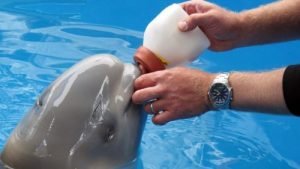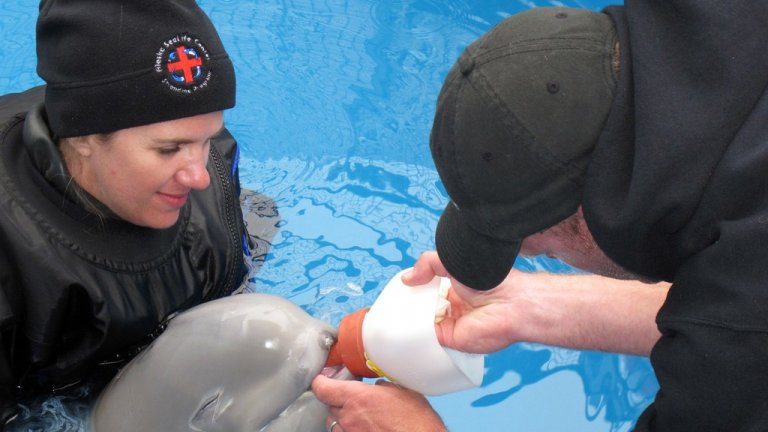Meet an Adorable Rescued Baby Beluga Whale
5 minutes

Published: 31 julio, 2018 13:15
At the end of September, a baby beluga whale appeared on an Alaskan beach, and a recovery center had to take care of it. Whale offspring cannot survive on their own, and so it could not return to the water by itself. This is the story of a rescued baby beluga whale.
Belugas are cetaceans that live in the Arctic and surrounding areas. A beluga whale reminds us of both a whale and a dolphin, although its closest relatives are narwhals. Belugas, when full grown, measure between three and five meters long and can weigh up to 1,200 kilos. They are social creatures that live and travel in groups.
Tyonek, the rescued baby beluga whale
At the end of September 2017, a one-year old baby beluga whale appeared on an Alaskan beach. When they first saw him, the rescue team intended to return him to the sea, but they soon realized that he was very thin and had no strength to swim.
So, they decided to pick him up and take him to the Alaska Sealife Center. In the hours following his arrival, beluga experts arrived from various cities in the United States to help care for the rescued baby beluga whale and to help him recover.
When he arrived at the center, they discovered that the rescued baby beluga whale was a male, about four weeks old. He was thin and dehydrated, so much so, that he could not maintain his own body heat.
The rescued baby beluga whale: weak but healthy
The experts began to control every aspect of his health as soon as he came to the center: they did blood tests, bacterial cultures, and monitored his breathing. After they were able to hydrate him, they began to notice improvements in his health. In just a few days, he began to swim on his own and to play with his caretakers.
For the first few days, he was so weak that they had to feed him through a tube every three hours. But, after a couple of weeks, he already had the strength to suckle from a bottle. However, because of the bottle, he began to suffer from gas colic, like human babies do, and her caretakers had to help her to burp!
Currently, little beluga is still being cared for. His only heath problems were dehydration and a low weight.
What is the Alaska Sealife Center?
The Alaskan Sealife Center is the only aquarium open to the public in Alaska. It also serves as a marine life recovery center, since it takes care of orphaned and injured animals. Some animals can be returned to life in the wild, but those who would not survive must remain in the care of the recovery center.
The rescued baby beluga whale is not in a pool that is open to the public, at the moment. Beluga experts monitor him 24-hours a day/7-days a week, in an indoor pool. This is much quieter and more controlled environment than the aquarium pools.

Experts have not made a decision as yet, but in such cases there are usually no plans to return rescued whale calves back to the wild. They do not know why he was separated from his group, and they doubt that he would be able to join his group again. Moreover, since he has spent so much time around humans instead of other belugas, he would not know how to hunt or how to survive by himself in the wild.
What to do if you see a stranded cetacean
Every year there are news stories about stranded cetaceans, everywhere in the world. Cetaceans that are disorientated or sick, and end up on a beach, range from large whales to dolphins. They can even be babies from all different species, such as this baby beluga.
When an animal is sick, the speed with which humans act is very important to their recovery. Knowing what to do for the animal and respecting its space is essential for it to survive. In the summer of 2017, a group of tourists found a stranded baby dolphin. Instead of helping her, they took selfies with her until she died.
This unfortunate news outraged the entire world. Therefore, it is important to know what to do if you encounter an endangered animal. First, check whether the animal is alive or not. See whether it is breathing, and if it moves its eyes.
If it is alive, call 911 to notify a specialized rescue team, and follow their instructions. If you are in an accessible area, protect the animal from stress caused by people. In other words, if there are curious people in the area, keep them away. Normally, emergency services will ask you to keep the animal in the shade and hydrated. You can do this by placing wet towels on the animal and by constantly tossing sea water on it.
Although it may seem like you could return the animal to the sea alone, you should not do so unless a veterinarian says that he is healthy and can survive. If he is stranded on a beach, it is because he is sick or has no strength to swim. To return him to the sea would be to condemn him to death.
If the stranded animal is already dead, you must notify the Civil Guard’s Nature Protection Service or any police unit dedicated to flora and fauna, so that they can remove the body. In no case should you touch a dead animal’s corpse, because you could get sick.
Your help is important
Tyonek, the rescued baby beluga whale, is recovering very well, thanks to the fast and accurate intervention of the person who found him stranded on a beach. Being responsible and knowing what to do in cases like these is essential for an endangered animal to survive.
Image source: www.telecinco.es
At the end of September, a baby beluga whale appeared on an Alaskan beach, and a recovery center had to take care of it. Whale offspring cannot survive on their own, and so it could not return to the water by itself. This is the story of a rescued baby beluga whale.
Belugas are cetaceans that live in the Arctic and surrounding areas. A beluga whale reminds us of both a whale and a dolphin, although its closest relatives are narwhals. Belugas, when full grown, measure between three and five meters long and can weigh up to 1,200 kilos. They are social creatures that live and travel in groups.
Tyonek, the rescued baby beluga whale
At the end of September 2017, a one-year old baby beluga whale appeared on an Alaskan beach. When they first saw him, the rescue team intended to return him to the sea, but they soon realized that he was very thin and had no strength to swim.
So, they decided to pick him up and take him to the Alaska Sealife Center. In the hours following his arrival, beluga experts arrived from various cities in the United States to help care for the rescued baby beluga whale and to help him recover.
When he arrived at the center, they discovered that the rescued baby beluga whale was a male, about four weeks old. He was thin and dehydrated, so much so, that he could not maintain his own body heat.
The rescued baby beluga whale: weak but healthy
The experts began to control every aspect of his health as soon as he came to the center: they did blood tests, bacterial cultures, and monitored his breathing. After they were able to hydrate him, they began to notice improvements in his health. In just a few days, he began to swim on his own and to play with his caretakers.
For the first few days, he was so weak that they had to feed him through a tube every three hours. But, after a couple of weeks, he already had the strength to suckle from a bottle. However, because of the bottle, he began to suffer from gas colic, like human babies do, and her caretakers had to help her to burp!
Currently, little beluga is still being cared for. His only heath problems were dehydration and a low weight.
What is the Alaska Sealife Center?
The Alaskan Sealife Center is the only aquarium open to the public in Alaska. It also serves as a marine life recovery center, since it takes care of orphaned and injured animals. Some animals can be returned to life in the wild, but those who would not survive must remain in the care of the recovery center.
The rescued baby beluga whale is not in a pool that is open to the public, at the moment. Beluga experts monitor him 24-hours a day/7-days a week, in an indoor pool. This is much quieter and more controlled environment than the aquarium pools.

Experts have not made a decision as yet, but in such cases there are usually no plans to return rescued whale calves back to the wild. They do not know why he was separated from his group, and they doubt that he would be able to join his group again. Moreover, since he has spent so much time around humans instead of other belugas, he would not know how to hunt or how to survive by himself in the wild.
What to do if you see a stranded cetacean
Every year there are news stories about stranded cetaceans, everywhere in the world. Cetaceans that are disorientated or sick, and end up on a beach, range from large whales to dolphins. They can even be babies from all different species, such as this baby beluga.
When an animal is sick, the speed with which humans act is very important to their recovery. Knowing what to do for the animal and respecting its space is essential for it to survive. In the summer of 2017, a group of tourists found a stranded baby dolphin. Instead of helping her, they took selfies with her until she died.
This unfortunate news outraged the entire world. Therefore, it is important to know what to do if you encounter an endangered animal. First, check whether the animal is alive or not. See whether it is breathing, and if it moves its eyes.
If it is alive, call 911 to notify a specialized rescue team, and follow their instructions. If you are in an accessible area, protect the animal from stress caused by people. In other words, if there are curious people in the area, keep them away. Normally, emergency services will ask you to keep the animal in the shade and hydrated. You can do this by placing wet towels on the animal and by constantly tossing sea water on it.
Although it may seem like you could return the animal to the sea alone, you should not do so unless a veterinarian says that he is healthy and can survive. If he is stranded on a beach, it is because he is sick or has no strength to swim. To return him to the sea would be to condemn him to death.
If the stranded animal is already dead, you must notify the Civil Guard’s Nature Protection Service or any police unit dedicated to flora and fauna, so that they can remove the body. In no case should you touch a dead animal’s corpse, because you could get sick.
Your help is important
Tyonek, the rescued baby beluga whale, is recovering very well, thanks to the fast and accurate intervention of the person who found him stranded on a beach. Being responsible and knowing what to do in cases like these is essential for an endangered animal to survive.
Image source: www.telecinco.es
This text is provided for informational purposes only and does not replace consultation with a professional. If in doubt, consult your specialist.








